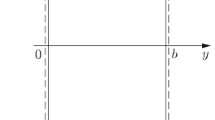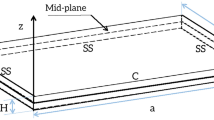Abstract
The effect of boundary condition nonlinearities on free nonlinear vibrations of thin rectangular plates is analyzed. The method for analysis of the plate vibrations with geometrical nonlinearity and the boundary condition nonlinearity is suggested. The nonlinear boundary conditions for membrane forces are transformed into linear ones using the in-plane stress function. Additional boundary conditions for the in-plane displacements vanishing on the clamped edge of the plate are imposed on the stress function. Simply supported and cantilever plates are analyzed. The backbone curves obtained by satisfying linear and nonlinear boundary conditions are compared. It is shown that the results of the calculations with nonlinear boundary conditions differ essentially from the data obtained without these boundary conditions.






Similar content being viewed by others
References
Leissa, A.W., Kadi, A.S.: Curvature effects on shallow shell vibrations. J. Sound Vib. 16, 173–187 (1971)
Sathyamoorthy, M., Pandalai, K.A.V.: Vibration of simply supported-clamped skew plates at large amplitudes. J. Sound Vib. 27, 37–46 (1973)
Prabhakara, M.K., Chia, C.Y.: Non-linear flexural vibrations of orthotropic rectangular plates. J. Sound Vib. 52, 511–518 (1977)
Sathyamoorthy, M.: Vibration of skew plates at large amplitudes including shear and rotatory inertia effects. Int. J. Solids Struct. 14, 869–880 (1978)
Stavridis, L.T., Armenakas, A.E.: Analysis of shallow shells with rectangular projection: theory. J. Eng. Mech. 114, 923–942 (1988)
Nguyen, H., Ostiguy, G.L.: Effect of boundary conditions on the dynamic instability and non-linear response of rectangular plates, part I: theory. J. Sound Vib. 133, 381–400 (1989)
Ostiguy, G.L., Sassi, S.: Effects of initial geometric imperfections on dynamic behavior of rectangular plates. Nonlinear Dyn. 3, 165–181 (1992)
Sassi, S., Ostiguy, G.L.: Effects of initial geometric imperfections on the interaction between forced and parametric vibrations. J. Sound Vib. 187, 41–54 (1994)
Sassi, S., Ostiguy, G.L.: On the interaction between forced and combination resonances. J. Sound Vib. 188, 51–67 (1995)
Asik, M.Z., Vallabhan, C.V.G.: On the convergence of nonlinear plate solutions. Comput. Struct. 65, 225–229 (1997)
Stavridis, L.T.: Dynamic analysis of shallow shells of rectangular base. J. Sound Vib. 218, 861–882 (1998)
Touze, C., Thomas, O., Amabili, M.: Transition to chaotic vibrations for harmonically forced perfect and imperfect circular plates. Int. J. Non-Linear Mech. 46, 234–246 (2011)
Touze, C., Thomas, O., Chaigne, A.: Asymmetric non-linear forced vibrations of free-edge circular plates, part I: theory. J. Sound Vib. 258, 649–676 (2002)
Amabili, M.: Nonlinear vibrations of rectangular plates with different boundary conditions: theory and experiments. Comput. Struct. 52, 2587–2605 (2004)
Amabili, M.: Theory and experiments for large-amplitude vibrations of rectangular plates with geometric imperfections. J. Sound Vib. 291, 539–565 (2006)
Amabili, M.: Nonlinear Vibrations and Stability of Shells and Plates. Cambridge University Press, New York (2008)
Woo, J., Meguid, S.A., Ong, L.S.: Nonlinear free vibration behavior of functionally graded plates. J. Sound Vib. 289, 595–611 (2006)
Amabili, M.: Non-linear vibrations of doubly curved shallow shells. Int. J. Non-Linear Mech. 40, 683–710 (2005)
Amabili, M.: Theory and experiments for large-amplitude vibrations of circular cylindrical panels with geometric imperfections. J. Sound Vib. 298, 43–72 (2006)
Meirovitch, L.: Elements of Vibration Analysis. McGraw-Hill, New York (1998)
Mushtari, Kh.M., Galimov, K.Z.: In: Nonlinear Theory of Thin Elastic Shells. NSF-NASA, Washington (1961)
Grigoluk, E.I., Kabanov, V.V.: Buckling of Shells. Nauka, Moscow (1978) (in Russian)
Chia, C.Y.: Non-Linear Analysis of Plates. McGraw-Hill, New York (1980)
Parker, T.S., Chua, L.O.: Practical Numerical Algorithms for Chaotic Systems. Springer, New York (1989)
Filippov, A.P.: Vibrations of Deformable Systems. Mashinostroenie, Moscow (1970) (in Russian)
Barton, C.W.: Vibration of rectangular and screw cantilever plates. J. Appl. Mech. 18, 129–134 (1951)
Author information
Authors and Affiliations
Corresponding author
Appendices
Appendix 1: Displacement-based method
The projections of middle plane points’ displacements u(x,y,t);v(x,y,t);w(x,y,t) are used as the main unknowns in this appendix. The plate kinetic energy takes the following form [16]:
The expression for the potential energy is published in [16]. The nonlinear oscillations are expanded in the truncated series [16]:
where W i , U i , V i are eigenmodes of linear vibrations. Note that the eigenmodes satisfy the geometric boundary conditions and the linearized boundary conditions for the membrane forces.
The expressions (33) are substituted into the kinetic and potential energies. The kinetic and potential energies are obtained as functions of the generalized coordinates and velocities. Then the Lagrange equations are derived. As eigenfrequencies of longitudinal vibrations are significantly higher than the eigenfrequencies of bending vibrations, the longitudinal inertia is not taken into account [23]. The Lagrange equations take the form (26), (27) with N=N w +N u +N v . The algebraic equations (27) are linear with respect to the generalized coordinates \(\varphi_{N_{w} + 1},\ldots,\varphi_{N}\). The solutions of these equations are expressed as a quadratic form with respect to the generalized coordinates φ i ,i=1,…,N w . These solutions are substituted into the Lagrange equations (26), and the dimensionless variables (28) are used. As a result, the dynamical system in the form (29) is obtained.
The eigenmodes of cantilever plate that are used in expansion (33) are obtained by the Rayleigh–Ritz method (Appendix 3).
Exact eigenmodes of simply supported plate are well known. They have the following form [16]:
Appendix 2: Mixed formulation neglecting the clamped edge boundary conditions u=v=0
The model of the plate vibrations that does not satisfy two boundary conditions (22) and (23) is considered. This is the main difference between this model and the one considered in Sect. 3. The main unknowns of the problem are w(x,y,t) and Φ(x,y,t), which are presented in the form of the expansions (19) and (20). In the considered case the trial functions F i of the expansion (20) satisfy only the boundary conditions for the membrane forces. We emphasize that the boundary condition (9) is ignored. The approach from Sect. 3 is used to derive a system of ordinary differential equations of plate vibrations. The geometric boundary conditions for w(x,y,t) and all force boundary conditions are satisfied.
Now the vibrations of the cantilever rectangular plate are considered. The trial functions of the expansion (20) take the following form:
The functions Φ i are chosen from the orthogonality conditions of F i . The functions Φ i are polynomials. We emphasize that the functions Φ i (x,y) do not satisfy the boundary conditions (22) and (23).
The trial functions Φ i (x,y) for the cantilever plate are considered. Numerical calculations show that it is enough to take the following two trial functions:
where
We want to underline that Φ 1 does not depend on both x and y. Φ 2(y) is a linear function of y and does not depend on x.
Appendix 3: Analysis of plate linear vibrations
Nonlinear dynamics of the plate is expanded into series with eigenmodes (19) and (20). The eigenmodes of the simply supported plate W i (x,y), U i (x,y), V i (x,y) are well known. The Rayleigh–Ritz method is applied to obtain approximate eigenmodes of the cantilever plate. The linear periodic vibrations are presented in the following form:
The minimum value of the Lagrange functional L=K−Π is determined to obtain the parameters of the plate linear vibrations. In order to obtain this minimum, the eigenmodes of the plate vibrations are expanded into the truncated series of the trial functions:
where w i ,u i ,v i are trial functions. The expressions (36) are substituted into the Lagrange functional, and the following function is obtained: \(L = L(a_{1},\ldots,a_{N_{3}})\). The determination of the Lagrange functional minimum is reduced to the following system: ∂L/∂a j =0, j=1,…,N 3. These equations can be presented in the form of the eigenvalue problem:
where \(\tilde{A} = ( a_{1},\ldots,a_{N_{3}} )\), M is the mass matrix, and K is the stiffness matrix.
The trial functions of the expansion (3.1) are considered. These functions are taken in the form of the product of the orthonormalized polynomials w i (x,y)=T i (x)P i (y), where
The trial functions of the expansions (36) for u,v are taken as u i (x,y)=v i (x,y)=T i (x)M i (y). The orthonormalized polynomials M i (y) are the following:
Rights and permissions
About this article
Cite this article
Breslavsky, I.D., Avramov, K.V. Effect of boundary condition nonlinearities on free large-amplitude vibrations of rectangular plates. Nonlinear Dyn 74, 615–627 (2013). https://doi.org/10.1007/s11071-013-0993-6
Received:
Accepted:
Published:
Issue Date:
DOI: https://doi.org/10.1007/s11071-013-0993-6




